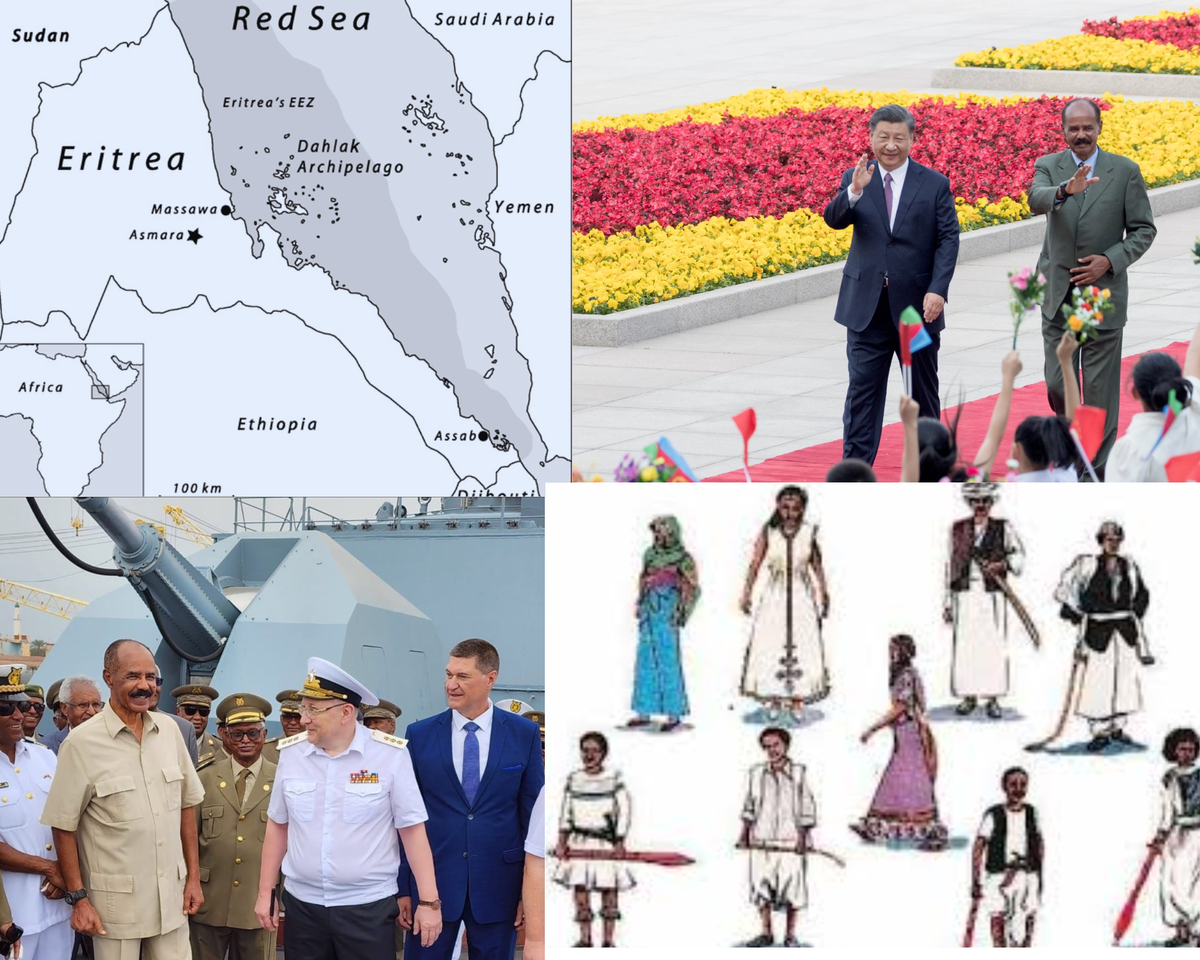‘Who are you calling little?’ Reviewing an oft-used – and inaccurate – label
Explore Eritrea beyond the "small and weak" label. Uncover historical contexts and geopolitical motives. Discover its rich history and developmental achievements, challenging misconceptions. Delve into hidden truths revealing Eritrea's true significance.

Dr. Fikrejesus Amahazion April 2024
When one spends any amount of time following the mainstream media’s coverage of Eritrea, they tend to quickly come to realize that the country is portrayed and analyzed in a manner that leaves a lot to be desired. One obvious problem is how coverage is overwhelmed with darkness and negativity, with hardly any inclusion of nuance or context. There is also a fair bit of fake news and baseless accusations. At the same time, any progress, positive developments, or successes unfolding across the nation, of which there are certainly many, tend to be completely disregarded or not afforded the appropriate level and depth of attention that they merit.
Another significant flaw within the prevailing discourse and coverage of the country is the language and tone used in reference to the country. Invariably, it is described as being any one or a combination of small, tiny, little, a backwater, weak, frail, or feeble. This is problematic for several reasons, two of which particularly stand out.
A look at the numbers and the flawed framing of importance
First, the propagated portrayal is inaccurate, making Eritrea seem distinctively small. For instance, in terms of size, Eritrea stretches to cover an area of approximately 124,000 kms2. For a better perspective, this makes it (depending on which particular international organization’s measurements you choose) among the largest 100 countries by area and ahead of about 100 other countries and dependencies.
What’s more, Eritrea’s territorial waters cover an area of about 55,000 km2, while the country has well over 350 islands of varying sizes, with most of them concentrated within the Dahlak archipelago, east of Massawa. When the country’s constellation of islands is taken into account, Eritrea’s total shoreline, stretching from its northern border with Sudan to its southern border with Djibouti, spans approximately 3,500 km, making it one of the longest in all of Africa, behind only Madagascar, Somalia, South Africa, Mozambique, and Egypt. Again, depending on which particular international organization’s measurements you choose to use, its length of coastline ranks among the 50 longest in the world.
Meanwhile, by population, the country’s total of approximately 3.7 million people would place it in around 130th place – still larger than many dozens of countries. Based on the simple objective numbers, the exclusive use of terms such as small, tiny, and little to refer to Eritrea is inaccurate.
The second problem relates to what the portrayal can often lead us to believe. Specifically, the frequent misrepresentations and exaggerated portrayal of Eritrea as uniquely small or weak contribute to framing it as inconsequential, lacking significance or import, and ultimately having less value. The reality, of course, is that no countries are inherently irrelevant or without value. Like other countries, Eritrea has much of worth to offer and contribute.
Hardly a new phenomenon
Interestingly, the mischaracterization of Eritrea as uniquely small and weak is not a new or recent phenomenon. It actually dates back nearly a century, when certain global and regional players—Britain, the US, and Ethiopia, to be precise—manufactured and propagated it in pursuit of their particular political interests.
For instance, in the Preface to his 1945 book, A Short History of Eritrea, Brigadier Stephen H. Longrigg, a civilian who from 1942 to 1944 served as chief administrator of the British Military Administration (BMA) in Eritrea, wrote that “rich or great, Eritrea will never become; it may, indeed, disappear as a political unit completely from the map. But few who have lived and worked there will view it otherwise than with sympathy.” Then, in an article penned a year later, he described Eritrea as “barely self-supporting” and the “most artificial and least stable of units.”
The period of the BMA in Eritrea was additionally marked by British skullduggery, interventions, and underhanded attempts to sow local division, instigate havoc, and fragment Eritrea in a variety of ways, including through political sabotage and stoking violence. This served to further solidify the picture of Eritrea as weak and divided.
Ethiopia, too, attempted to depict Eritrea as frail. In a 1947 speech delivered before the Council of Deputies of Foreign Ministers at the United Nations, Aklilu Habtewold, then Vice Minister of Foreign Affairs of Ethiopia, claimed that Eritrea was “unable to live by itself” and that it depended on Ethiopia “for its economic and commercial livelihood and the livelihood of its seaports.” Other officials and scholars, all proponents of the chauvinistic, misguided notion of an expansionist, cohesive empire, regularly followed suit. Writing after the imperial regime’s illegal annexation of Eritrea and during the outbreak of Eritrea’s struggle for independence, Edward Ullendorff erroneously claimed that “Eritrea was never a viable unit economically.”
For the British, propagating the imagery of Eritrea as small, weak, and divided – and therefore ultimately unviable as a sovereign, independent entity – would help strengthen their aim of partitioning Eritrea, with the resultant parts being incorporated into imperial Ethiopia and Anglo-Egyptian Sudan. For Ethiopia, the depiction was just one part of the imperial regime’s multipronged attempt to bring Eritrea under its rule. The US, meanwhile, precluded independence for Eritrea, supporting Ethiopia on the basis that “Eritrea as an inevitably weak state [would be] exposed to Soviet aggression or infiltration.”
Of course, the descriptions and portrayals were far from accurate then as they are today. For example, while Eritrea remained under Italian colonial rule for a half-century until 1941, the period sparked socioeconomic transformation, urbanization, and significant industrial progress. This included the construction of modern port facilities, health centers, airports, workshops and factories, roads, railways, and communication facilities that were among the best in Africa, along with an array of other infrastructure. Notably, in the audacious Teleferica Massaua-Asmara, a nearly 75-km aerial tramway running from Massawa to Asmara, Eritrea boasted the longest cableway within Africa and the entire world.
Also, in an enlightening 2006 article, the Eritrean scholar Rahel Almedom wrote how, after assuming control of Eritrea following Italian colonization, “the British had inherited a thriving local economy,” while even Brigadier Longrigg was forced to acknowledge that Eritrea was, “highly developed,” and had, “superb roads, a railway, airports, a European city as its capital, [and] public services up to European standards.”
Additionally, as put by two Westerners who lived in Eritrea, “In 1935 Asmara [which was made the Eritrean capital in 1897] was the most modern and progressive city in Italian East Africa,” while at the same time, the port of Massawa boasted the most extensive harbor facilities between Alexandria and Cape Town. Other Eritrean cities also reflected progress and industrialization. Tessenei was a hub for transportation and economic activity, while Dekemhare, about 40-kms south of Asmara, was referred as “zona industria” and “secondo Milano” and full of busy factories and industries.
The simple fact is that one of the main reasons the British, Ethiopians, and the US worked so hard to portray Eritrea as weak and so heavily pressed their claims regarding the country was because it was full of development and considerable economic potential.
Recall how, during the years of the BMA in Eritrea, the British, who reneged on their promise of independence to Eritreans should they help them defeat the Italians, even proceeded to dismantle many industries and most of the infrastructure that had been developed in Eritrea. Later, after Eritrea’s eventual federation and annexation, a large percentage of Ethiopia’s national manufacturing output and total revenues were derived from Eritrea, while many highly educated and skilled Eritreans also made significant contributions to different sectors in Ethiopia.
Western officials at the time often cited Eritrea’s potential and development as an important factor in helping modernize Ethiopia. British Ambassador Dan Lascelles, for example, explained, “Ethiopia is admittedly a very backward and primitive country. The acquisition by her of the greater part of Eritrea will accelerate this process by leavening the mass. The need for competently trained officials in the Ethiopian government is acute. In these circumstances, can we be at all sure that it would be ‘morally wrong and politically an error’ to leaven the mass by giving this African territory (Eritrea) to another adjacent African state even if it does mean ‘economic and social regression’ for the territory in question?” Similarly, in a 1959 telegram to the Department of State in Washington, Matthew J. Looram, the American Consul in Asmara, remarked, “Certainly Eritrea has an economic potential that could provide extensive business opportunities and serve to develop significantly the Eritrean economy.”
For Group Prices to Eritrea and Tour Packages, Call Select Concierge at 1-800-640-8107Western officials at the time


Comments ()